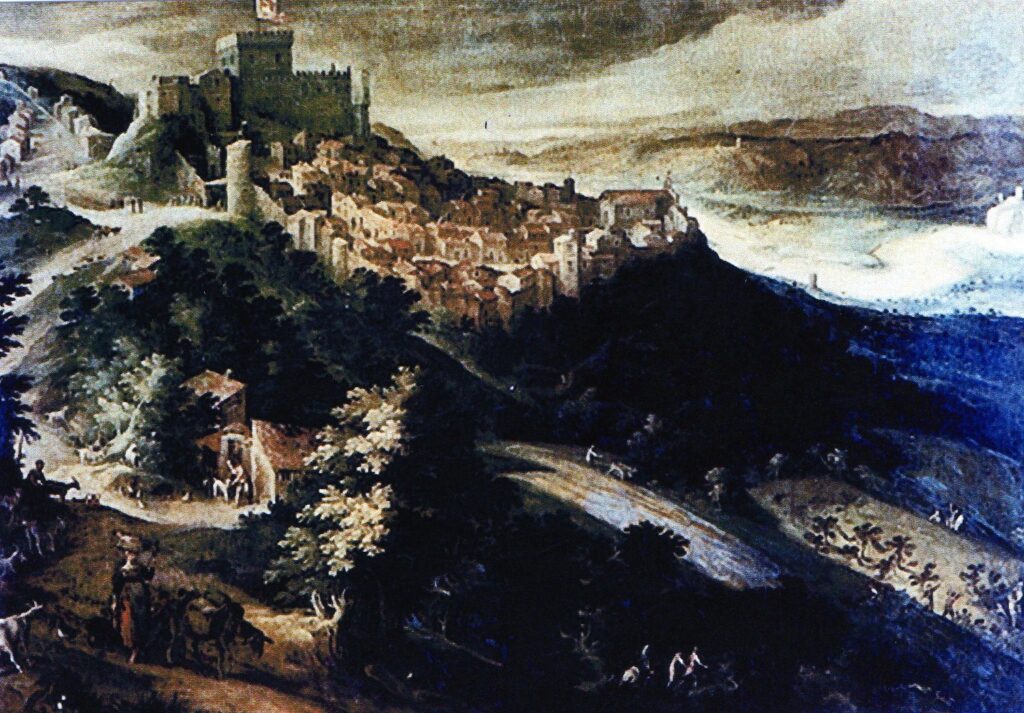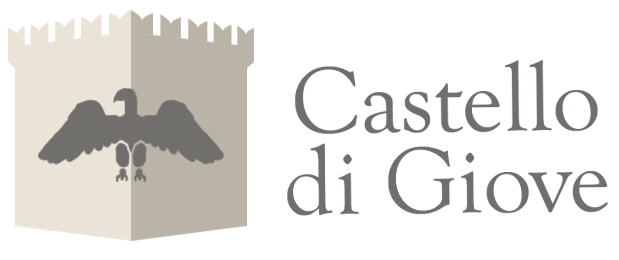Circondato dal suo antico borgo, incastonato tra l’Umbria e il Lazio, il Castello domina dall’alto la verde valle del Tevere con una sguardo che si estende a 360 gradi dai monti Cimini al monte Amiata fino agli Amerini e al Soratte.
Un castello/palazzo che rievoca un glorioso passato e che ha visto le sue splendide sale frequentate da personaggi illustri con le numerose casate che si sono succedute nel corso dei secoli e che hanno fatto la storia dell’Italia. Celebrazioni, danze ma anche contese e conflitti con le segrete carceri sotterranee e i cunicoli che attraversavano il paese.
The ancient castle was probably built on the ruins of a temple dedicated to Jupiter Elicius. The first traces date back to 1191, in a document it was called Castel di Juvo, and it appeared as a well-fortified agglomeration to protect the Tiber valley.
Throughout the 13th century the castle was always at the center of violent disputes between Orvieto and Todi, until the latter in 1256, after the agreement between Orvieto and Perugia, regained possession of it, placing Count Raniero dei Baschi, head of the Ghibellines, who, after having allied themselves with Spoleto, besieged Camerino in 1259.
L’odio di Raniero verso la città marchigiana risaliva ad alcuni anni prima, quando in sua assenza truppe camerinesi al comando di Crescio dei Monaldi avevano arrecato danni al castello di Giove, infierendo contro alcuni suoi parenti. I Baschi, fedeli ghibellini, si trovarono sempre in sintonia con Todi che verso di loro dimostrò amicizia e solidarietà in parecchie occasioni.
In 1308 Giove was occupied by the Guelphs of Amelia led by Carolus Nicolai and Offreduccio II of Alviano.
In 1320, Sciarra I Colonna (podestà of Narni in 1297, captain of the Todine militias in 1310) took possession of it; in January 1328 Sciarra I, senior captain of the people in Rome, crowned Louis IV the Bavarian (1286-1347) emperor; Colonna was driven out of Rome and died in exile in 1329.
In 1333 Giovanni Orsini, cardinal legate in Tuscany, besieged Giove and after committing brutal crimes, destroyed a good part of the fortress. Pope John XXII (1316-1334), angry at the serious episode, had Orsini imprisoned in the prisons of Amelia on 20 March 1333.
From 1359 it became a fiefdom of Tommaso d'Alviano, son of Ugolino, belonging to the Guelph branch of the family; in 1364 it became the stronghold of the Black Company of Anichino Bongardo which for over three years devastated the entire area up to Terni. The ferocious mercenary company, called from Perugia in 1364, camped in Pila where they reached an agreement with the White Company of Giovanni Acuto.
In 1378 the area witnessed the passage of the ferocious Bretons, followers of the antipope Clemente VII (1378-1394), sent by the French cardinals to aid Francesco di Vico, lord of Viterbo.
After the mid-15th century, Giove fell into the hands of Everso d'Anguillara, lord of vast domains and a man of arms at the service of the papacy and the rebels; his sons, Francesco († 1473) and Deifobo († 1490), after the death of their father (4 September 1464), continued to occupy fiefdoms and castles, thanks to the friendship of the new Pope Paolo II (Pietro Barbo, 1464-1471 ), their godfather. The pope, however, tired of the numerous warnings due to the brutality of their behavior, excommunicated them and with the help of Federico II da Montefeltro and Nicolò II Orsini took Giove back under the dominion of Rome in 1465.
La lotta intrapresa contro gli Anguillara si concluse con il loro annientamento e con lo smembramento delle proprietà che essi avevano acquisito (Caprarola, Ronciglione e Capranica).
In 1503 the ancient fortress fell under the attack of Cesare Borgia who also dismantled all its defensive works.
In 1515, Ottavio Farnese, duke of Castro and Ronciglione and lord of Attigliano, took office as governor and sent his daughter Contarina Farnese there.

On 4 July 1597 Matteo Farnese sold the fiefdom to the brothers Ciriaco and Asdrubale Mattei, relatives of the Orsini and Colonna families, who built the splendid Renaissance palace, which was later transformed into a noble residence.
Papa Urbano VIII (1623-1644) nel 1643 concesse infine a Girolamo Mattei, marchese di Giove, il titolo di duca.

From the Mattei, a Roman family that gave the Church eight cardinals (Alessandro Mattei, an illustrious cardinal, was the owner of the palace in 1816), it passed to the Mattei-Canoni. Later Caterina Mattei, the last heir, passed it on to her son, Marquis Carlo Canonici.
When Carlo died without heirs, the palace was inherited by the Duchess Maria Anna Mattei who married the Marquis Carlo Teodoro Antici of Recanati, whose son Matteo, senator in 1859, took the surname Antici-Mattei. The Marquise Adelaide Antici, mother of Giacomo Leopardi, was a guest in the palace and in 1910 King Vittorio Emanuele III, who was visiting the area.
Dagli Antici passò a Pietro Ricciardi, al generale Mario Nicolis Robilant (1855-1943) e nel 1936 è stato acquistato dal Conte Pietro d’Acquarone che fece importanti lavori di ripristino al castello a seguito degli ingenti danni subiti nel 1915 con il terremoto di Avezzano.
Il corpo principale dell’edificio si articola su cinque piani, con tre torri angolari di cui una crollata in parte; nelle facciate si aprono ben 365 finestre, una per ogni giorno dell’anno. Una delle torri deriva dalla incorporazione dell’antica torre della rocca che si legge nel quadro di Paul Bril conservato nel Museo di Palazzo Barberini a Roma.
The internal halls are decorated with paintings of mythological themes, attributed to Domenico Zampieri (1581-1641) known as Domenichino.
Between 1985 and 2014 it was owned by the American director and producer of fantasy-horror films Charles Robert Band.
A Dicembre 2014 è stato acquistato dall’attuale proprietà che lo ha interamente restaurato anche grazie ai fondi per la ricostruzione erogati in seguito al sisma del 2016 che ha provocato ingentissimi danni rendendo completamente inagibile il castello.
